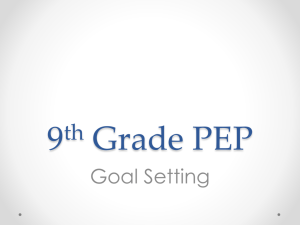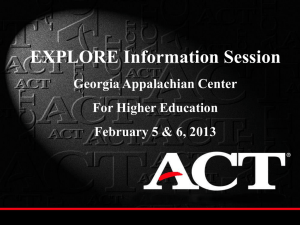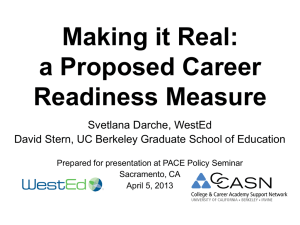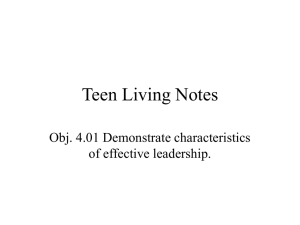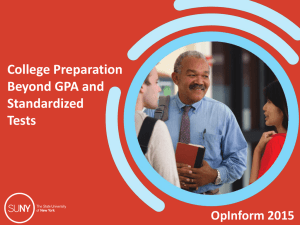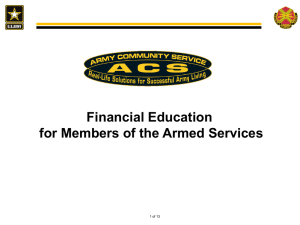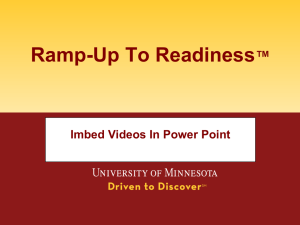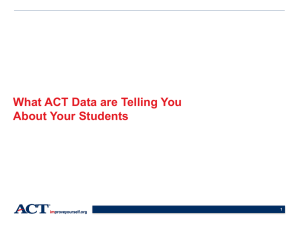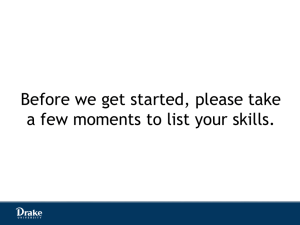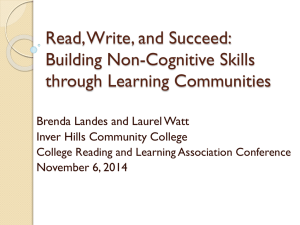10th, Q2, Goal Setting - Denver Public Schools Counseling
advertisement
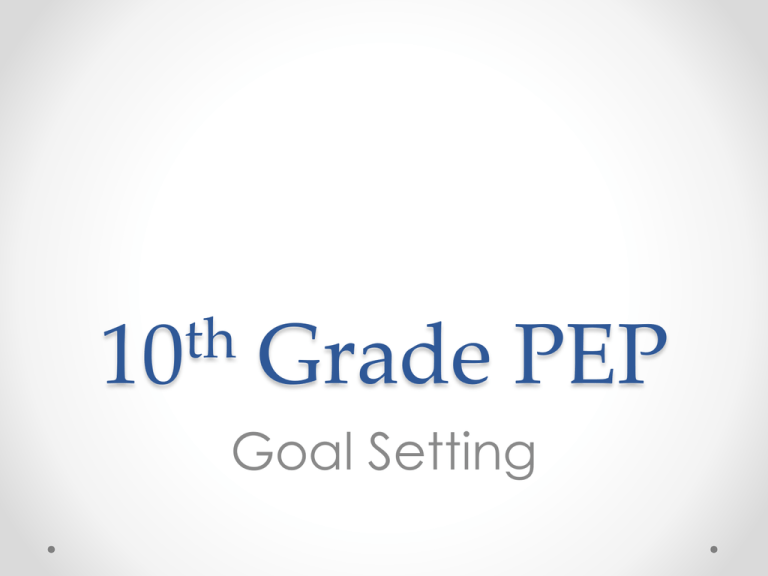
th 10 Grade PEP Goal Setting Overview 1. Review Personal Education Plan (PEP) goals 2. Use college and career readiness definition and indicators to discuss pathways to these goals 3. Use rubric to evaluate strengths and areas of improvement related to college and career readiness 4. Review service learning and extracurricular opportunities 5. Build resume in Naviance to document progress toward goals What are your PEP goals? PEP Goals Career Goal/Plan Post Secondary Goal/Plan Academic Goal/Plan Goal + Path • What is the path to reach these college/career goals? Goal + Path • College and Career Readiness is defined as possessing the academic knowledge, 21st century learning skills, and non-cognitive abilities that enable students to successfully contribute to the global community and pursue postsecondary education without remediation. • What are the 3 major components you see? 1. Academic knowledge 2. 21st Century Skills 3. Non-cognitive abilities GOAL: College, Career, and Academic Goal(s)__ ______________________ ______________________ - Academic Behaviors (e.g. “I attend class and complete my homework” - Academic Beliefs (e.g. 3) Non-cognitive Abilities, which include… “I can improve with effort”) 2) 21st Century and Workforce Readiness Skills (e.g. communication, collaboration, creativity, and critical thinking 1) Academic Knowledge (e.g. Academic Performance (grades, TCAP) and 4-Year Plan Path to college and Career Readiness Goal + Path + Motivation • Click link to view video: • People who are motivated to set goals and create paths toward goals tend to… o http://www.youtube.com/watch?v=zpgS4jgvzQU&feature=youtu.be o Set learning-based goals within their reach (NOT performance-based goals that may be outside their control) o Have internal desire to learn new skills and master new tasks o Track progress and increase effort with failure or setback o Create new paths to goals when face obstacles or barriers o Use positive self-talk (e.g. “Keep going!” “You can get this done.”) o Receive higher scores on achievement tests, higher overall grade point averages, and higher graduation rates, even when controlling for intelligence o Have self-esteem, confidence, and perceived problem-solving abilities and sense of control o Have less anxiety Snyder, C.R., Shorey, H.S., Cheavens, J., Pulvers, K.M., Adams, V.H., and Wiklund, C. (2002). Hope and Academic Success in College, Journal of Educational Psychology, 94, 820-826. Readiness Rubric Academic Knowledge • Academic knowledge includes core academic subject mastery in reading, writing, math, and science as measured by student grades and standardized assessments (e.g. TCAP and college entrance exams) • Get out your College & Career Readiness Rubric and complete the first section entitled, “Academic Knowledge” (Example responses) 3.2 GPA Is this student developing or meeting, according to his/her GPA? TCAP? 21st Century Skills The knowledge, skills, and behaviors to be successful in post-secondary and career. Invention Readiness Rubric st 21 Century Skills • Use the College & Career Readiness Rubric to assess your development of “21st Century and Workforce Readiness Skills” (Example responses) Non-Cognitive Abilities • Non-cognitive abilities refer to the behaviors, skills, attitudes, and strategies that are not reflected in test scores, but are crucial to both academic, college, and lifelong career performance. • Non-cognitive abilities include the following: • Beliefs (e.g. belief that one can improve with effort and hard work as well as the belief that one is responsible for his/her successes and failures) • Behaviors (e.g. attendance, homework completion, study skills, learning strategies, and persistence) Readiness Rubric Non-cognitive Beliefs Use the readiness rubric to assess your Academic Beliefs (Example responses) Research on Noncognitive Beliefs • Students who responded positively to Academic Mindset questions (questions 1 – 3 from previous slide), display what is called a growth mindset. • Students with a growth mindset… o Believe that their abilities and intelligence can grow and change through effort and learning. o View mistakes as learning opportunities. o Are more likely to choose challenging tasks and less likely to give up when things get difficult o Are more likely to improve their test scores and GPA over time. Readiness Rubric Non-cognitive Behaviors Use the readiness rubric to assess your Academic Behaviors Research on Noncognitive Behaviors • Attendance: o Researchers followed Chicago 8th grade students with the lowest standardized test scores as they entered high school. The lowest scoring students who had less than a week of absences in a semester passed more of the 9th grade courses than students who entered HS with the highest test scores but who missed just one more week of class (Allensworth and Easton, 2007). Research on Noncognitive Behaviors • Homework: o Students with the lowest standardized test scores (i.e. bottom third) who spent over 10 hours per week on homework were able to raise their grades to mostly B’s, the same grade as students with the highest standardized test scores who did not do their homework (Keith, 1982). o Time spent on homework has a positive effect on both grades and standardized test scores. Research on Noncognitive Behaviors • Attendance and study habits strongly predict student’s grades, even more than standardized test scores or any other student background characteristics. • Grades predict high school and college performance and graduation • Grades even predict people’s future alary. o For each point increase in GPA, men and women earned 20% more money in their jobs 9 years after high school, even after controlling for educational attainment (Miller, 1998). o Why might this be? Because students who attend class and complete their work are likely to practice work habits needed in college as well as in the workforce. Self-Assessment & Goal Setting • For those who finish early, o Complete discussion questions and evaluate your areas of strength and areas for improvement. o Select one of the categories where you most need to improve (e.g. academic performance, 21st century skills, non-cognitive attitudes, or noncognitive behaviors) o Write a goal statement. Include what steps you will take, by when, to see improvement in this area. Service Learning & Extracurricular Activities Service Learning & Extracurricular Activities • College and career readiness goals include both academic as well as other non-cognitive indicators. • As a result, it makes sense that many of these beliefs, behaviors, and skills are learned outside the classroom, through activities that support but are not directly a part of your academic program. • Examples: 1. Service Learning activities (e.g. Community Builders, Youth in Service to America, etc.) 2. Extracurricular activities (e.g. sports teams, clubs, explorers programs, pre-collegiate programs, etc.) • Service learning and extracurricular activities can help you discover your talents, explore your interests, reach your goals and even build your resume. Service Learning Opportunities • Service-learning is combining work on a community project with classroom studies. It is volunteering your time with the end goal of using skills you have learned in the classroom. • Benefits: Hands-on experiences assist in your learning. Looks great on your college applications or resumes. Your community is a better place because of your efforts. Encourages growth in your problem-solving, leadership, and decisionmaking skills. o Could lead to possible career options in your future. o Provides you with the opportunity to meet and work with leaders in your community o o o o • See handout for Service Learning Opportunities Extracurricular Opportunities • List or discuss extracurricular opportunities available at your school. • Discuss where students can go to find out more information and how to sign up. • Discuss relevant eligibility requirements. Extra-curricular Career Exploration Opportunities • www.denverexploring.org has a listing of all the career clubs in the Denver Metro area. Kathy Turner is the contact person if you have questions regarding Exploring 720-266-2242. • www.exploringyourcareer.org is the new online survey (not assessment) where students can pick two careers and we can directly mail them an invite to these open houses they might be interested in based on their responses. Resume Building Resume • Resume o Document that highlights your academic and co-curricular strengths; your relevant skills, including 21st century and workforce skills; and your work habits, experiences, and behaviors. o Used as a tool to market or sell yourself when applying for a job, scholarship, college program, or another related opportunity. • According to Job Outlook 2012 National Association of Colleges and Employers, employers look for evidence of the following on a resume… 1. 3. Ability to work in a team 2. Leadership skills Written communication skills 4. Problem-solving skills 5. Strong work ethic Naviance Resume Builder • Open a new tab and log-in to Naviance using the following Username and Password Student ID # mmddyy Click, “Log In” Naviance Naviance Resume Components • Click on the drop down menu to complete the highlighted sections. • • • • Volunteer Service Extracurricular Activities Awards/Certificates Leadership • If you have extra time, please complete other relevant sections related to other specific achievements, etc. Objective Summary Work Experience Education Volunteer Service Extracurricular Activities Awards/Certificates Skills/Academic Achievement Music/Artistic Achievement Athletic Achievement References Leadership
